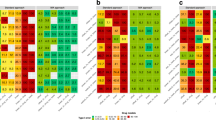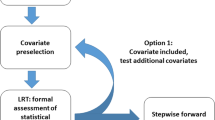Abstract
Analysis of longitudinal ordered categorical efficacy or safety data in clinical trials using mixed models is increasingly performed. However, algorithms available for maximum likelihood estimation using an approximation of the likelihood integral, including LAPLACE approach, may give rise to biased parameter estimates. The SAEM algorithm is an efficient and powerful tool in the analysis of continuous/count mixed models. The aim of this study was to implement and investigate the performance of the SAEM algorithm for longitudinal categorical data. The SAEM algorithm is extended for parameter estimation in ordered categorical mixed models together with an estimation of the Fisher information matrix and the likelihood. We used Monte Carlo simulations using previously published scenarios evaluated with NONMEM. Accuracy and precision in parameter estimation and standard error estimates were assessed in terms of relative bias and root mean square error. This algorithm was illustrated on the simultaneous analysis of pharmacokinetic and discretized efficacy data obtained after a single dose of warfarin in healthy volunteers. The new SAEM algorithm is implemented in MONOLIX 3.1 for discrete mixed models. The analyses show that for parameter estimation, the relative bias is low for both fixed effects and variance components in all models studied. Estimated and empirical standard errors are similar. The warfarin example illustrates how simple and rapid it is to analyze simultaneously continuous and discrete data with MONOLIX 3.1. The SAEM algorithm is extended for analysis of longitudinal categorical data. It provides accurate estimates parameters and standard errors. The estimation is fast and stable.






Similar content being viewed by others
References
Ito K, Hutmacher M, Liu J, Qiu R, Frame B, Miller R. Exposure-response analysis for spontaneously reported dizziness in pregabalin-treated patient with generalized anxiety disorder. Clin Pharmacol Ther. 2008;84:127–35.
Mandema JW and Stanski DR. Population pharmacodynamic model for ketorolac analgesia. Clin Pharmacol Ther. 1996;60:619–35.
Zingmark PH, Ekblom M, Odergren T, Ashwood T, Lyden P, Karlsson MO, et al. Population pharmacokinetics of clomethiazole and its effect on the natural course of sedation in acute stroke patients. Br J Clin Pharmacol. 2003;56:173–83.
Zingmark PH, Kagedal M, Karlsson MO. Modelling a spontaneously reported side effect by use of a Markov mixed-effects model. J Pharmacokinet Pharmacodyn. 2005;32:261–81.
Sheiner LB. A new approach to the analysis of analgesic drug trials, illustrated with bromfenac data. Clin Pharmacol Ther. 1994;56:309–22.
Kjellsson MC, Zingmark PH, Jonsson EN, Karlsson MO. Comparison of proportional and differential odds models for mixed-effects analysis of categorical data. J Pharmacokinet Pharmacodyn. 2008;35:483–501.
Verbeke G. Mixed models for the analysis of categorical repeated measures. PAGE 15. Abstr 930. 2006. www.page-meetingorg/?abstract=930
Jonsson S, Kjellsson MC, Karlsson MO. Estimating bias in population parameters for some models for repeated measures ordinal data using NONMEM and NLMIXED. J Pharmacokinet Pharmacodyn. 2004;31:299–320.
Fitzmaurice G, Davidian M, Verbeke G, Molenberghs G. Longitudinal data analysis. New York: Chapman & Hall; 2009.
Bauer RJ, Guzy S, Ng C. A survey of population analysis methods and software for complex pharmacokinetic and pharmacodynamic models with examples. AAPS J. 2007;9:E60–83.
Kuhn E and Lavielle M. Maximum likelihood estimation in nonlinear mixed effects models. Comput Stat Data Anal. 2005;49:1020–38.
Lavielle M and Mentre F. Estimation of population pharmacokinetic parameters of saquinavir in HIV patients with the MONOLIX software. J Pharmacokinet Pharmacodyn. 2007;34:229–49.
Savic R and Lavielle M. Performance in population models for count data, part II: a new SAEM algorithm. J Pharmacokinet Pharmacodyn. 2009;36:367–79.
Ezzet F and Whitehead J. A random effects model for ordinal responses from a crossover trial. Stat Med. 1991;10:901–6. discussion 906–907.
Bazzoli C, Retout S, Mentre F. Fisher information matrix for nonlinear mixed effects multiple response models: evaluation of the appropriateness of the first order linearization using a pharmacokinetic/pharmacodynamic model. Stat Med. 2009;28:1940–56.
O’Reilly RA and Aggeler PM. Studies on coumarin anticoagulant drugs. Initiation of warfarin therapy without a loading dose. Circulation. 1968;38:169–77.
O’Reilly RA, Aggeler PM, Leong LS. Studies on the coumarin anticoagulant drugs: the pharmacodynamics of Warfarin in Man. J Clin Invest. 1963;42:1542–51.
Karlsson MO and Savic RM. Diagnosing model diagnostics. Clin Pharmacol Ther. 2007;82:17–20.
Savic RM and Karlsson MO. Importance of shrinkage in empirical Bayes estimates for diagnostics: problems and solutions. AAPS J. 2009;11:558–69.
Plan EL, Maloney A, Troconiz IF, Karlsson MO. Performance in population models for count data, part I: maximum likelihood approximations. J Pharmacokinet Pharmacodyn. 2009;36:353–66.
Plan EL, Maloney A, Troconiz IF, Karlsson MO. Maximum likelihood approximations: performance in population models for count data. PAGE 17. Abstr 1372. 2008. wwwpage-meetingorg/?abstract=1372.
Dubois A, Gsteiger S, Pigeolet E, Mentre F. Model-based bioequivalence analysis of pharmacokinetic crossover trials compared to standard non-compartmental analysis. PAGE. 2010.
Zhang L, Beal SL, Sheiner LB. Simultaneous vs. sequential analysis for population PK/PD data I: best-case performance. J Pharmacokinet Pharmacodyn. 2003;30:387–404.
Zhang L, Beal SL, Sheinerz LB. Simultaneous vs. sequential analysis for population PK/PD data II: robustness of methods. J Pharmacokinet Pharmacodyn. 2003;30:405–16.
Acknowledgments
Radojka Savic was financially supported by a postdoctoral grant from the Swedish Academy of Pharmaceutical Sciences (Apotekarsocieteten). We thank the MONOLIX team, Hector Mesa, and Kaelig Chatel for their help with implementation of the algorithm in the MONOLIX software. We also thank two anonymous reviewers for their valuable comments on the manuscript.
Author information
Authors and Affiliations
Corresponding author
Rights and permissions
About this article
Cite this article
Savic, R.M., Mentré, F. & Lavielle, M. Implementation and Evaluation of the SAEM Algorithm for Longitudinal Ordered Categorical Data with an Illustration in Pharmacokinetics–Pharmacodynamics. AAPS J 13, 44–53 (2011). https://doi.org/10.1208/s12248-010-9238-5
Received:
Accepted:
Published:
Issue Date:
DOI: https://doi.org/10.1208/s12248-010-9238-5




